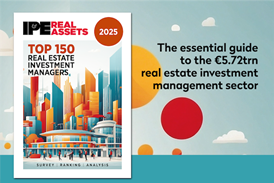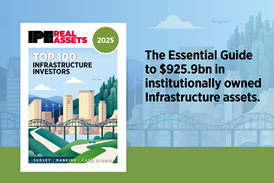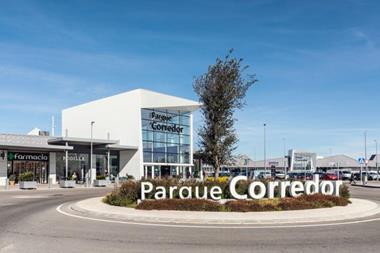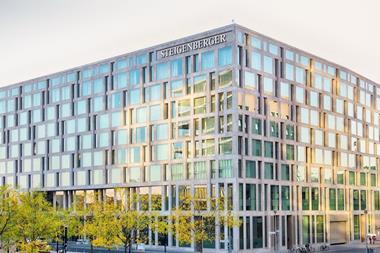EPRA had plenty to crow about at the annual conference of the European Public Real Estate Association in Paris last week.
EPRA had plenty to crow about at the annual conference of the European Public Real Estate Association in Paris last week.
Admittedly, Hammerson’s CEO David Atkins did his best to inject a critical note during his welcome address as outgoing EPRA chairman and began his speech with the comment that the size and relevance of Europe's listed real estate sector remain a serious source of concern. But despite this sobering message and warnings by economists Ian Shepherdson and Andrea Boltho that interest rates are normalising again and that rising rates will be the story for the next three years, a mood approaching rationalised self-congratulation dominated the event. Indeed, the video clips highlighting EPRA's recent achievements and the goals of its Investor Outreach programme would not look misplaced on the corporate websites of its members.
To be fair, any event held in Paris is reason for a party and this year marks - not entirely coincidentally - the 10th anniversary of the tax-friendly French SIIC. In the past decade, the French equivalent of the Anglo-Saxon REIT has become a veritable success story, delegates learned. Together they account for a market capitalisation of some €60 bn or roughly 40% of the entire listed French universe.
While the German listed real estate market remains a dwarf compared to its French neighbour, it too is at least making some headway, EPRA's CEO Philip Charls argued. Citing the number of newly floated companies in Germany in the past 12 months, he pointed out that these had boosted the market capitalisation of the German property sector by some €3 bn. 'Germany's share of the European index has grown from 8% to 10%. That's still too low but it is growing, slowly but surely,' he said.
Good news
Charls had another piece of good news for European property stock watchers. More Irish property companies may seek a stock market listing following the IPO of Green REIT which raised over €100 mln above its original €200 mln target in a listing on the Irish stock exchange in July. In the next five years, Ireland may see five more REITs emerge with a market capitalisation of €5 bn, the delegates heard.
EPRA itself is also in expansive mode, Charls said. On 1 September the Brussels-based organisation appointed an Asian Investor Outreach Manager office in Hong Kong to tap the capital wave from Asia for listed European real estate. The office will be run by Yuri Zhou, a former research associate for Citi Research in Hong Kong. A strategic and wise move give that China has gone from being a manufacturer of cheap goods to being one of the biggest suppliers of capital around the globe, a role it will continue to play for the next two decades at least.
A party in Paris is all the merrier when there is good cheer from the UK. Of course, the UK will always remain an island in Europe but forget those long-faced Eurosceptics: the Brits had heartening news for their continental cousins. In recent years, the UK capital has felt like a different country within the country thanks to the strong performance of the London property sector. But the good news is that the real estate recovery is not just going nationwide, it may now also spread to the Continent, noted Nick Webb, property analyst at Exane BNP Paribas, during a meeting with the press.
Capital values have already broken their 18-month losing streak, while key leading indicators - like the RICS survey - suggest that 2014 could be the first year of average rental growth since 2007. ‘Back before the financial crisis, UK commercial real estate started falling earlier, faster and harder than Continental European markets. We may see markets on the other side of the channel starting to take a similar shape in recovery, but again lagging the UK on the way up,’ Webb predicted.
British companies are not just spearheading the European property recovery, they are also turning in the best results for financial and sustainability reporting, according to the latest EPRA surveys on these twin topics. London-listed companies including British Land, Capital & Counties, Derwent London, Intu Properties, Hammerson, Land Securities and Segro chalked up half of the gold awards for the best Epra annual report and four of this group - British Land, Derwent London, Hammerson and Segro - went on to receive the highest gold award for sustainability reporting.
The annual report survey, conducted by Deloitte, reviewed 86 annual reports that focussed on EPRA’s performance measures, with 79% of the companies surveyed disclosing at least one performance measure. In total, 43 awards were issued, or 10 more than last year, Jennifer Chase, director at Deloitte said. ‘The survey results this year have taken a big leap forward with half of the companies surveyed achieving awards. The domino effect is taking hold, with more companies responding to peer and market pressure to adopt the best practice recommendations.’
A similar ‘leap’ was registered in sustainability reporting, EPRA’s outgoing finance director Gareth Lewis said. This year’s results show that seven companies disclosed sustainability performance publicly for the first time, bringing the total number now adopting the EPRA Sustainability Best Practices Recommendations (sBPR) to half of the 86 companies in the EPRA index. ‘Once again, the listed property sector has shown that it is leading the charge in driving up standards of reporting across the broader property sector by being responsive to the needs of the investment community.’
Green stars
While the UK accounts for a major chunk of that investment community, so do the Dutch with their mammoth pension fund schemes. Indeed, APG - the investment management arm of civil servants pension fund ABP - is a staunch proponent of sustainability initiatives such as sBPR and GRESB (Global Real Estate Sustainability Benchmark). Announcing the results of GRESB’s latest survey at the conference, APG’s CEO Patrick Kanters noted that half of the world's 'Green Stars' are located in Europe. And - to put yet another feather in EPRA’s cap - listed companies in Europe continue to do slightly better than their non-listed peers, the GRESB report revealed.
While the Brits stole the show in terms of their reporting performance, the French also had something to boast about. The tax-friendly SIIC has become the norm in France, noted Maryse Aulagnon, CEO of Affine, during a panel session on the French listed sector. In fact, the word about the success of the SIIC is spreading beyond French shores and Morocco has recently adopted a similar regime, she reported. It is also developing further elsewhere in Africa as well as Asia, she added. ‘It is turning into the normal standard which is very important. We are operating in a global environment and need to have the same references.’
The SIIC regime has been amended several times over the past 10 years, but despite the regular rule changes, the benefits have been significant, particularly in terms of financing. Affine, for example, pays an all-in rate of 3.3% on its loans and the larger players have led the way with tapping into alternative forms of financing such as bond issuances.
Having said that, the non-listed equivalent of the SIIC - or OPCI - is arguably a bigger success story, Aulagnon indicated. Although OPCIs were not introduced until 2007, France now counts 187 of these non-listed vehicles compared to 47 SIICs, Aulagnon noted. Moreover, their success is due precisely to the fact that they are not listed and thus more flexible, she said, adding that they do not suffer either from a discount to NAV. The OPCI vehicle has become a common structure for bringing together a club deal or institutional players co-investing in a development project, but only recently have they started to raise money. Nevertheless, they are not competitors to SIICs, Aulagnon argued. ‘They are complementary, a different way of working. In fact, some SIICs have an OPCI or are working on one.’
Light at the end of the tunnel
A European REIT remains as elusive as ever, but a European REIT Passport modelled on the French SIIC regime would certainly be a good second-best option, the panel concluded. That is not to say that France does not have worries of its own. Indeed, its inability to reform the labour market remains a major sticking point for recovery further down the track, economist Ian Shepherdson warned. ‘If you want to lose sleep, think about France!’
But with the possible exception of France and a smattering of other countries like Spain and the Netherlands where house prices are still too high, light is emerging at the end of the tunnel, fellow-economist Andrea Boltho said. Of course, eurozone productivity is still too low and excessive public debt will continue to feed doubts about the future of the eurozone so the light at the end of the tunnel may well be a train, he continued. In any case recovery is likely to be fairly modest.
At the same time the fear of collapse has subsided even if the ECB’s pledge to do whatever it takes to keep the eurozone together has not yet been seriously challenged, he concluded.
As for the looming threat of rising interest rates, UK long-term interest rates have already responded to the improvement in the UK’s fundamental economic environment, according to Nick Webb of Exane BNP Paribas. Between May and July, the 10-year UK government bond (gilt) yield rose 100 basis points to 2.6%.
And to end on an upbeat note, rising interest rates are not as big a worry for property markets as many people think, he said. Statistical analysis by Exane BNP Paribas reveals that the long-term statistical correlation between UK property equivalent yields and nominal gilt yields is zero while inflation expectations appear to be the key driver of property values. Research also shows that pension funds have historically allocated higher proportions of their assets to property in high interest rate environments than in low ones.
After Paris, the property party may well be just beginning.
JUDI SEEBUS
EDITOR-IN-CHIEF










